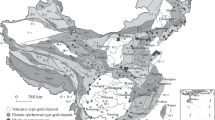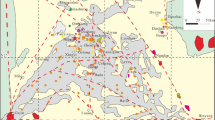Abstract
The Nibao gold deposit is one of the typical Carlin-type gold deposits in the Youjiang Basin. In these areas, the presence of As and S is closely involved in Au mineralisation. However, considering that excessive amounts of As and S can be harmful to human health and to the environment, studying the three-dimensional (3D) enrichment regularities of Au, As, and S can help acknowledge the details of the gold mineralisation process, and guide processes such as mineralisation prediction, prospecting exploration, and mine construction. Here, 3Dmine software is used to create a 3D visual geological modelling of the Nibao gold deposit. The models show that the concentration of Au, As, and S is abundant in the area and have similar enrichment regularities. Results have pointed out that the main enrichment strata are P3l1 and P3l2, and the main enrichment locations are F1, the Sbt, and the Erlongqiangbao anticline. The areas with high contents of Au, As, and S are formed with the occurrence of strata and fault. Combining the results here presented with the outcomes of previous studies on the material and fluid sources of Au in the Nibao gold deposit, we have concluded that the mineralisation process relies on the migration of over pressure fluids that are rich in Au, As, S, and poor in Fe. Because of the lithological changes and tectonic influences, they emerge from depth along the deep large faults, and then flow into F1, resulting in the flow of fluids into the parts with good permeability, and water–rock reaction with Fe-rich rocks, especially sulfidation occurs, generating arsenic-bearing pyrite which provides a carrier for Au enrichment into the deposit. The 3D distribution characteristics and correlation of among Au, As, and S are qualitatively and quantitatively analysed, and our results revealed that the three elements are positively correlated in the overall. This correlation was further divided into two sections. In the first section, the Au content ranged from 0 to 2 × 10−6; there is a good positive correlation among Au, As, and S. In the second section, the content of Au content was > 2 × 10−6, and higher amounts of Au would imply higher amounts of As and S as well. Considering the above outcomes, the enrichment regularities and correlation among Au, As, and S can be used as a reference index in the metallogenic prediction and prospecting exploration of the Nibao gold deposit and similar deposits. These are valid especially areas with higher concentration of As and S, which are the prospecting target. Furthermore, there will be a large number of As and S in the process of mining, smelting, slag treatment, and green restoration of the mine, so measures need to be taken to avoid excessive As and S from causing health hazards to workers and environmental pollution.
Similar content being viewed by others
References
Cao ST, Zheng LL, Wei HR et al (2021) Study on three-dimensional gold enrichment regularity and metallogenic model of Nibao large-scale gold deposit, southwestern Guizhou. Geol Rev 67(05):1297–1308 (in Chinese with English abstract)
Chen J, Huang ZL, Yang RD et al (2020) Discovery of SEDEX gold in the Youjiang basin, SW China: Implications for a new type Au mineralization. Chin Sci Bull 65(15):1486–1495 (in Chinese with English abstract)
Chen MH, Leon B, Liao X et al (2019) Hydrothermal apatite SIMS Th Pb dating: constraints on the timing of low-temperature hydrothermal Au deposits in Nibao, SW China. Lithos 324–325:418–428
Cline, J.S., Muntean, J.L., Gu, X.X., et al., 2013. A comparison of Carlin-type gold deposit: Guizhou Province, Golden Triangle, Southwest China, and northern Nevada, USA. Earth Sci Frontiers (China University of Geosciences (Bei**g). 20(1): 1–18.
He, C.X., Long, W.J., Zhu, F.F., 2012. Probability theory and mathematical statistics. Higher Education Press, Bei**g, pp.1–244 (in Chinese).
Hu RZ, Su WC, Bi XW et al (2002) Geology and geochemistry of Carlin-type gold deposits in China. Miner Deposita 37(3–4):378–392
Hu RZ, Peng JT, Ma DS et al (2007) Epoch of large-scale low-temperature mineralizations in southwestern Yangtze massif. Mineral Deposits 26(6):583–596 (in Chinese with English abstract)
**, X.Y., 2017. Geology, mineralization and genesis of the Nibao, Shuiyindong and Yata gold deposits in SW Guizhou province, China (PhD. thesis). China University of Geosciences (Wuhan), PP.1–208 (in Chinese with English abstract).
** XY, Hofstra AH, Hunt AG et al (2020) Noble gases fingerprint the source and evolution of ore-forming fluids of Carlin-type gold deposits in the Golden Triangle. South China Econ Geol 115(2):455–469
** XY, Yang CF, Liu JZ et al (2021) Source and evolution of the ore-forming fluids of carlin-type gold deposit in the Youjiang Basin, South China: evidences from solute data of fluid inclusion extracts. J Earth Sci 32(1):185–194
Li JX, Zhao CH, Huang Y et al (2019) In-situ sulfur isotope and trace element of pyrite constraints on the formation and evolution of the Nibao Carlin-type gold deposit in SW China. Acta Geochimica 38(4):555–575
Liu Y, Gai JP, Liu Y (2009) 3DMine software applied in establishment of 3D mine geological model. Min Eng 2009(05):58–60 (in Chinese with English abstract)
Muntean JL, Cline JS (2018) Diversity of Carlin-style gold deposits. Rev Econ Geol 20:1–5
Nie, A.G., 2007. A mineralization mechanism as well as minerogenetic prospe carlin-type gold deposit in southwestern of Guizhou (PhD. thesis). Kunming University of Science and Technology, pp.1–142 (in Chinese with English abstract).
Sheng XY, Zhu XQ, Li XX et al (2016) Typomorphic characteristics of pyrite and source of ore-forming materials in Nibao Carlin type gold. Acta Mineralogica Sinica 36(4):563–570
Su WC, Zhang HT, Hu RZ et al (2012) Mineralogy and geochemistry of gold-bearing arsenian pyrite from the Shuiyindong Carlin-type gold deposit, Guizhou, China: implications for gold depositional processes. Miner Deposita 47(6):653–662
Su WC, Dong WD, Zhang XC et al (2019) Carlin-type gold deposits in the Dian-Qian-Gui “Golden Triangle” of Southwest China. Soc Econ Geol 20:157–185
Tu, G.Z., 1998. Low Temperature Geochemistry. Science Press, Bei**g, PP.1–266 (in Chinese).
Wei DT, **a Y, Tan QP et al (2016) Comparative study of the wallrock and ore and ore forming mechanisms at the Nibao gold deposit, Guizhou. China Acta Petrologica Sinica 32(11):3343–3359 (in Chinese with English abstract)
Wei DT, **a Y, Gregory DD, et al (2020) Multistage pyrites in the Nibao disseminated gold deposit, southwestern Guizhou Province, China: insights into the origin of Au from textures, in situ trace elements, and sulfur isotope analyses. Ore Geol Rev https://doi.org/10.1016/j.oregeorev.2020.103446
Wu SY, Hou L, Ding J et al (2018) Primary halo characteristics and deep ore body prospecting of the Nibao gold deposit, Guizhou Province: illustrated with the example of III-1 orebody. Bull Mineral Petrol Geochem 37(4):674–686 (in Chinese with English abstract)
Wu SY, Hou L, Jowitt SM, et al (2019) Geochronology, geochemistry and petrogenesis of Late Triassic dolerites associated with the Nibao gold deposit, Youjiang Basin, southwestern China: implications for post-collisional magmatism and its relationships with Carlin-like gold mineralization. Ore Geol Rev https://doi.org/10.1016/j.oregeorev.2019.102971
**e XY, Feng DS, Chen MH et al (2016) Fluid inclusion and stable isotope geochemistry study of the Nibao gold deposit, Guizhou and insights into ore genesis. Acta Petrologica Sinica 32(11):3360–3376 (in Chinese with English abstract)
**e, X.Y., 2018a. Ore-forming fluid and metallogenic mechanism study of the Nibao gold deposit, Guizhou province (MSc. thesis). Chin Acad Geol Sci PP.1–79 (in Chinese with English abstract).
**e ZJ, **a Y, Cline JS et al (2018) Are there Carlin-type gold deposits in China? A comparison of the Guizhou, China, deposits with Nevada, USA, deposits. Society of Economic Geologists, Inc. Rev Econ Geol Div Carlin-Type Gold Deposits 20:187–233
Zhang JR, Hou L, Zou ZC et al (2016) LA-ICP-MS in situ trace element of auriferous arsenic pyrites from the Nibao gold deposit and its constraints on ore genesis. Acta Petrologica Et Mineralogica 35(03):493–505 (in Chinese with English abstract)
Zheng LL, Yang RD, Gao JB et al (2016) Geochemical characteristics of the giant Nibao Carlin-type gold deposit (Guizhou, China) and their geological implications. Arab J Geosci 9(2):108–123
Zheng LL, Yang RD, Chen J et al (2017) Typomorphic characteristics of pyrite, arsenopyrite and occurrence of gold in the giant Nibao Gold Deposit, Pu’an, southwestern Guizhou. Geolog Rev 63(5):1361–1377 (in Chinese with English abstract)
Zheng LL, Yang RD, Liu JZ et al (2019a) Geological—geochemical characteristics and genesis genesis of the large Nibao gold deposit in southwestern Guizhou. Geol Rev 65(6):1363–1382 (in Chinese with English abstract)
Zheng LL, Yang RD, Gao JB et al (2019b) Quartz Rb-Sr isochron ages of two type orebodies from the Nibao Carlin-type gold deposit, Guizhou. China Minerals 9(7):3–15
Acknowledgements
We would like to extend our sincere appreciation to the 105 Geological Team, Guizhou Geology and Mineral Bureau, Guiyang, Guizhou, China, for providing the modelling data, and sincerely appreciate the editors’ and anonymous reviewer’s comments.
Funding
This research was supported by the National Natural Science Foundation of China (Nos. 41962008, 42062009), the scientific and technological innovation team project for metallogeny and exploration of Carlin-type gold deposits in Guizhou Province (No. Qian Ke He ** Tai Ren Cai CXTD [2021] 007), and the Science and Technology Plan Project of Guizhou Province (No.[2020]1Y158).
Author information
Authors and Affiliations
Contributions
S. Cao: methodology, data curation, building 3D geological models, formal analysis, writing — original draft, visualisation. L. Zheng: methodology, conceptualisation, writing — review and editing, supervision, funding acquisition. J. Liu: methodology, conceptualisation, providing data. H. Wei: methodology, conceptualisation, writing — review and editing. J. Chen: conceptualisation, writing — review and editing. W. Song: writing — review and editing. H. **e: review and editing. Z. Liu: data processing.
Corresponding author
Ethics declarations
Competing interest
The authors declare no competing interests.
Additional information
Responsible Editor: Domenico M. Doronzo
Rights and permissions
About this article
Cite this article
Cao, S., Zheng, L., Liu, J. et al. Study on three-dimensional enrichment regularities of Au, As, and S and their indicative significance in the giant Nibao gold deposit, Southwestern Guizhou, China. Arab J Geosci 15, 497 (2022). https://doi.org/10.1007/s12517-022-09794-w
Received:
Accepted:
Published:
DOI: https://doi.org/10.1007/s12517-022-09794-w














